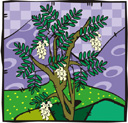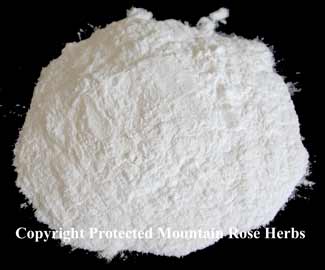
Gum acacia.
- botanical information
- origin
- history
- part used
- astrological correspondences
- magick correspondences and uses
- cautions and contraindications
botanical information:
Botanical name: Acacia senegal
Common name: acacia, gum acacia
Use the botanical name when ordering seeds (bulbs, etc.) or when looking up information in the library. Common names vary by nation, culture, and region, and sometimes the same common name is applied to different plants.
The tree that produces gum acacia is of the same genus (related species) as the tree that produces gum arabic and sometimes these two gums are interchangeably labelled.
Family: Fabaceae (bean)
origin:
Origin: Sudan.
history:
History: Acacia trees commonly lined ancient Egyptian temple gardens.

part used:
|
Part Used: The Gum. Farmers of Dafur harvest acacia gum in two stages. First, they strip bark from unhealthy plants. The acacias then form “tears” of gum that dry and can be collected later. The drops of gum are three-quarters to three inches (1.5 to 8 cm) in diameter, irregularly shaped, and beige or yellowish white. Information courtesy of Mountain Rose Herbs |
astrological correspondences:
Astrological planet: Sun ![]()
magickal correspondences and uses:
Gender: masculine (traditional western European magickal gender)
Magickal uses: burn for altar offerings, meditation, aids psychic powers
Magickal uses: the gum is used for making magickal incenses
Solar spells: Acacia (as an herbal gum) may be used in as an ingredient or substitute for magick spells and formulas related to solar matters (healing, illumination, magickal power, physical energy, protection, success, and putting an end to legal matters). Be careful about substitutions for preparations that will be ingested or come in contact with the skin. These substitutions do not apply to medical uses. See the article on the Sun for a list of herbal substitutes for gum acacia.
Magickal substitutions: Gum Arabic may be safely substituted for acacia or gum acacia in magick spells and rituals.

Magical Uses information courtesy of 
|
cautions and contraindications:
Cautions and contraindications: Acacia is believed to be safe.
Wild gathering: Avoid wild gathering. Some plants are endangered species. Please grow your own herbs in your own goddess garden (or window boxes).
Acacia and Gum Arabic Powder ProfilePicture and article courtesy of Mountain Rose Herbs
Also known as: Acacia senegal (acacia gum or true gum arabic), Acacia nilotica (Indian gum arabic), and Acacia seyhal (talha). Parts UsedThe gum. Farmers of Dafur harvest acacia gum in two stages. First, they strip bark from unhealthy plants. The acacias then form “tears” of gum that dry and can be collected later. The drops of gum are three-quarters to three inches (1.5 to 8 cm) in diameter, irregularly shaped, and beige or yellowish white. Typical PreparationsAcacia gum is used in a variety of products ranging from ink to ice cream. In herbal medicine, the gum is used to bind pills and lozenges and to stabilize emulsions. It is also used to produce a medium for applying essential oils, balsams, resins, camphor, and musk. Acacia gum forms strings when combined with cherry extract. Picture and article courtesy of Mountain Rose Herbs |
next gum
herbs |
||
| previous plant |
next plant |















